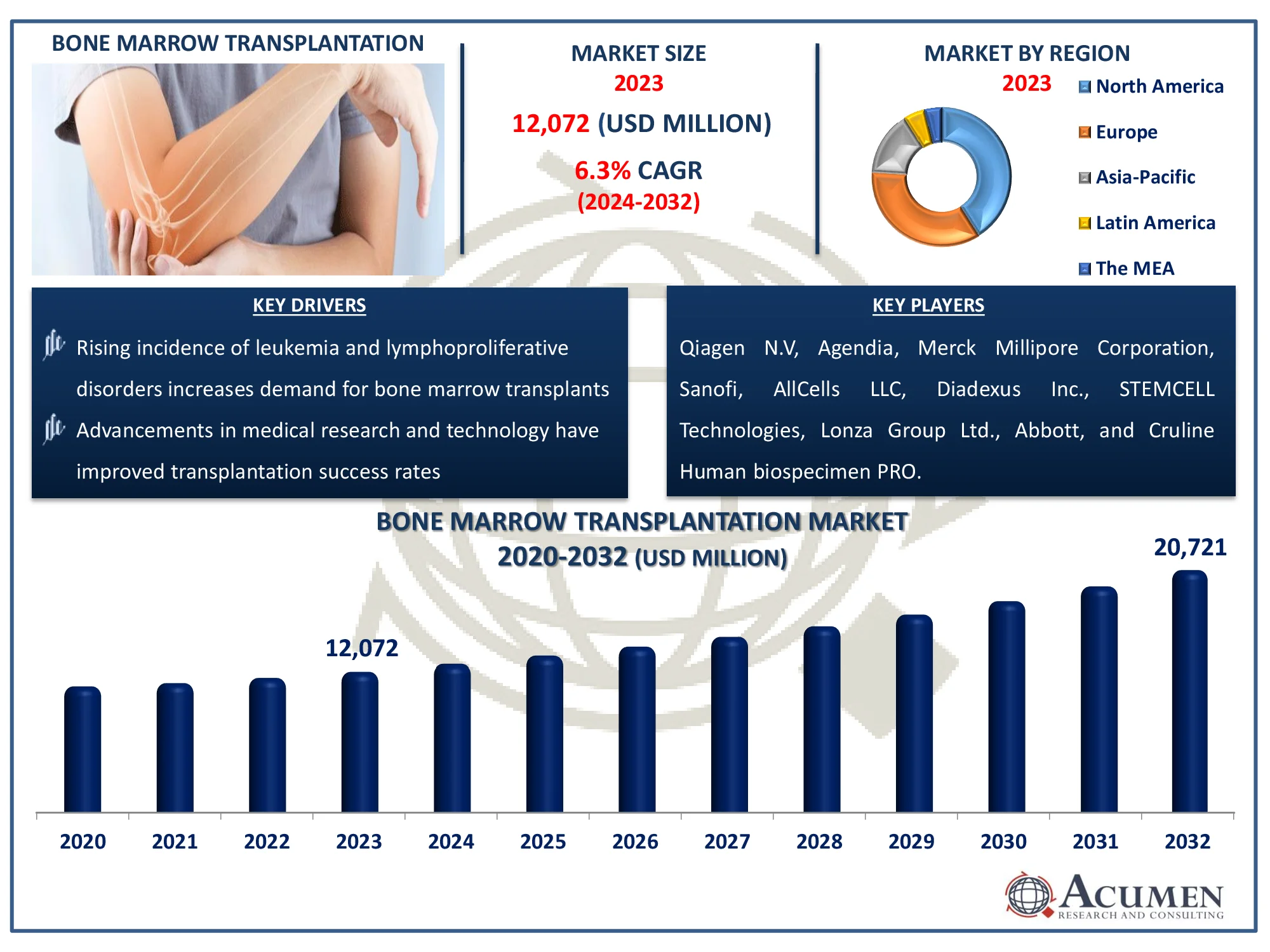Bone Marrow Transplantation Market Size - Global Industry, Share, Analysis, Trends and Forecast 2024 - 2032
Published :
Report ID:
Pages :
Format :
Bone Marrow Transplantation Market Size - Global Industry, Share, Analysis, Trends and Forecast 2024 - 2032
Report Coverage
- Industry Dynamics
- Market Size and Forecast Data
- Segment Analysis
- Competitive Landscape
- Regional Analysis with a Niche Focus on Country-Level Data
- High Level Analysis - Porter's, PESTEL, Value Chain, etc.
- Company Profiles of Key Players
- Option to Customize the Report As Per Your Specific Need
Request Sample Report
The Global Bone Marrow Transplantation Market Size accounted for USD 12,072 Million in 2023 and is estimated to achieve a market size of USD 20,721 Million by 2032 growing at a CAGR of 6.3% from 2024 to 2032.
Bone Marrow Transplantation Market Highlights
- The global bone marrow transplantation market is projected to reach USD 20,721 million by 2032, with a CAGR of 6.3% from 2024 to 2032
- In 2023, the North American bone marrow transplantation market held a value of approximately USD 4,949.4 million
- As per CIBMTR data, 5,073 unrelated and 4,276 related bone marrow and cord blood transplants were performed in the US in 2021
- According to Leukemia & Lymphoma Society, new cases of leukemia, lymphoma and myeloma accounted for 9.4% of the estimated 2,001,140 new cancer cases in the US in 2024
- The Asia-Pacific region is expected to grow at a CAGR of over 7.1% from 2024 to 2032
- Research and development activities in bone marrow transplantation expand therapeutic applications is the bone marrow transplantation market trend that fuels the industry demand
 Hematopoietic stem cell transplantation is the process of replacing diseased or weakened bone marrow or stem cells with healthy tissues. Bone marrow is a soft vascular tissue found within long bones that largely promotes the creation of blood cells, lymphocyte development, and fat accumulation. Bone marrow transplantation is recommended for severe cases of leukemia, Hodgkin and non-Hodgkin lymphomas, palatial, sickle cell anemia, and thalassemia, among other conditions. More than 75.000 bone marrow transplants were conducted worldwide in 2015, and the number is predicted to increase by 25% by the end of 2020.
Hematopoietic stem cell transplantation is the process of replacing diseased or weakened bone marrow or stem cells with healthy tissues. Bone marrow is a soft vascular tissue found within long bones that largely promotes the creation of blood cells, lymphocyte development, and fat accumulation. Bone marrow transplantation is recommended for severe cases of leukemia, Hodgkin and non-Hodgkin lymphomas, palatial, sickle cell anemia, and thalassemia, among other conditions. More than 75.000 bone marrow transplants were conducted worldwide in 2015, and the number is predicted to increase by 25% by the end of 2020.
Bone marrow transplantation is classified as either peripheral stem cell transplantation (PSCT) or conventional bone marrow transplantation, depending on the source of the bone marrow or stem cells. High demand for BMOs, combined with ongoing field work to lower the danger of unfavorable consequences from BMO transplantation, could result in a new market high for millions of people worldwide seeking to better their healthcare.
Global Bone Marrow Transplantation Market Dynamics
Market Drivers
- Rising incidence of leukemia and lymphoproliferative disorders increases demand for bone marrow transplants
- Advancements in medical research and technology have improved transplantation success rates
- Government initiatives and support enhance awareness and accessibility of bone marrow transplantation
Market Restraints
- High costs associated with bone marrow transplantation procedures limit patient accessibility
- Scarcity of compatible bone marrow donors poses challenges for transplantation
- Ethical issues and concerns related to bone marrow transplantation hinder market growth
Market Opportunities
- Technological advancements in bone marrow transplantation therapy offer improved treatment options
- Rising advancements in bone marrow transplantation
- Emerging indications of bone marrow transplant for heart and neuronal disorders present new market prospects
Bone Marrow Transplantation Market Report Coverage
|
Market |
Bone Marrow Transplantation Market |
|
Bone Marrow Transplantation Market Size 2023 |
USD 12,072 Million |
|
Bone Marrow Transplantation Market Forecast 2032 |
USD 20,721 Million |
|
Bone Marrow Transplantation Market CAGR During 2024 - 2032 |
6.3% |
|
Bone Marrow Transplantation Market Analysis Period |
2020 - 2032 |
|
Bone Marrow Transplantation Market Base Year |
2023 |
|
Bone Marrow Transplantation Market Forecast Data |
2024 - 2032 |
|
Segments Covered |
By Type, By Indication, By End-User, and By Geography |
|
Regional Scope |
North America, Europe, Asia Pacific, Latin America, and Middle East & Africa |
|
Key Companies Profiled |
Qiagen N.V, Agendia, Merck Millipore Corporation, Sanofi, AllCells LLC, Diadexus Inc., STEMCELL Technologies, Lonza Group Ltd., Abbott, and Cruline Human biospecimen PRO. |
|
Report Coverage |
Market Trends, Drivers, Restraints, Competitive Analysis, Player Profiling, Covid-19 Analysis, Regulation Analysis |
Bone Marrow Transplantation Market Insights
The growing number of cancer treatments is driving the bone marrow transplant market share. For example, the National Institutes of Health (NIH) predicts that the number of allogeneic and autologous bone marrow transplants is increasing worldwide. Bone marrow transplantation (BMT) has become the mainstay treatment for many patients with leukemia, lymphoma, multiple myeloma, and testicular cancer. Furthermore, increased bone marrow transplantation rates and an increase in anemia cases are boosting market expansion. Rapid technological developments in these treatments are one of the key bone marrow transplantation market trends driving industry growth.
Bone marrow transplantation is typically the final resort recommended by physicians for bone marrow and blood cancer patients. As a result, the rising prevalence of various disorders, most notably blood cancer, can be conveniently expected to be a major driver of the worldwide bone marrow transplantation industry's growth. Bone marrow malfunction can be especially damaging to the health of the body. In this regard, the growing prevalence of poor diets, inactivity, and alcohol and nicotine usage may be contributing to an increase in the demand for bone marrow transplants.
Bone marrow transplantation is on the rise, with patients increasingly favorable about the treatment. Patients' clinical status may improve as a result of intensive investigation and production of bone marrow transplants. This is predicted to significantly increase the worldwide bone marrow transplantation industry's success, as the operation remains unquestionably safe and technically advanced. Extensive research into the recruitment, processing, logistical, and biological aspects of donated bone marrow may account for increasing efficiency.
The incidence of blood cancer has risen during the last decade. Blood cancer occurs 1.5 times more frequently in impoverished countries than in developed areas. According to Shalby Hospitals, someone in India is diagnosed with blood cancer every 5 minutes, and over 70,000 people die from it each year. Increased per capita income has resulted in a large increase in healthcare spending in most industrialized countries. The overall need for bone marrow transplants in the country is likely to rise.
 Bone Marrow Transplantation Market Segmentation
Bone Marrow Transplantation Market Segmentation
The worldwide market for bone marrow transplantation is split based on type, indication, end-user, and geography.
Bone Marrow Transplantation Market By Type
- Allogeneic Bone Marrow Transplant
- Autologous Bone Marrow Transplant
According to the bone marrow transplantation industry analysis, autologous bone marrow transplants will hold a sizable market share in 2023. Furthermore, autologous bone marrow transplantation is anticipated to continue in the projection year. The first step in this sort of transplant is to extract or harvest the patient's stem cells. Their stem cells are taken from bone marrow or blood and frozen. One advantage of an autologous stem cell transplant is that the patient gets his or her own cells.
Bone Marrow Transplantation Market By Indication
- Myeloma
- Leukemia
- Lymphoma
- Thalassemia
- Solid Tumors
- Aplastic Anemia
- Sickle Cell Anemia
- Myelodysplastic Syndrome
- Myeloproliferative Disorders
- Others
According to the bone marrow transplantation industry analysis, leukemia is the dominant indication in the bone marrow transplant market due to the high incidence and mortality rates associated with the disease. The need for stem cell transplants in leukemia patients has driven significant growth in transplantation procedures. Other indications like myeloma and thalassemia also contribute but to a lesser extent compared to leukemia.
Bone Marrow Transplantation Market By End-User
- Hospitals
- Multispecialty Clinics
- Ambulatory Surgical Centre
According to the bone marrow transplantation market forecast, in 2023, the hospitals subsegment earned the most market revenue, and this trend is expected to continue in the coming years. The hospital segment is driven by enhanced medical infrastructure, competent healthcare professionals, and an increasing prevalence of cancer and anemia. Bone marrow transplants are used to treat advanced blood cancer, sickle cell disease, and other chronic conditions.
Bone Marrow Transplantation Market Regional Outlook
North America
- U.S.
- Canada
Europe
- U.K.
- Germany
- France
- Spain
- Rest of Europe
Asia-Pacific
- India
- Japan
- China
- Australia
- South Korea
- Rest of Asia-Pacific
Latin America
- Brazil
- Mexico
- Rest of LATAM
The Middle East & Africa
- South Africa
- GCC Countries
- Rest of the Middle East & Africa (ME&A)
 Bone Marrow Transplantation Market Regional Analysis
Bone Marrow Transplantation Market Regional Analysis
For several reasons, North America dominates bone marrow transplantation market. Europe is predicted to maintain its growing position in bone marrow transplantation market. The bone marrow industry would allow the area to prosper due to increased rates of chronic diseases such as blood cancer, as well as an aging population. The growing prevalence of lymphoproliferative diseases and leukemia raises demand for bone marrow transplants. For example, the National Institute of Health (NIH) reports that the incidence of leukemia and lymphoma is highest in more developed regions of Europe, Northern America, and Australia, as well as among White Americans. An exception to this is ALL, which has the highest frequency in South and Central American countries, and along with Hispanics in the United States.
Asia-Pacific is fastest-growing region for successful bone marrow transplantation may not be as high as the North American industries, which will also become an important medical tourism sector.
Bone Marrow Transplantation Market Players
Some of the top bone marrow transplantation companies offered in our report Qiagen N.V, Agendia, Merck Millipore Corporation, Sanofi, AllCells LLC, Diadexus Inc., STEMCELL Technologies, Lonza Group Ltd., Abbott, and Cruline Human biospecimen PRO.
Frequently Asked Questions
How big is the Bone Marrow Transplantation market?
The bone marrow transplantation market size was valued at USD 12,072 Million in 2023.
What is the CAGR of the global Bone Marrow Transplantation market from 2024 to 2032?
The CAGR of bone marrow transplantation is 6.3% during the analysis period of 2024 to 2032.
Which are the key players in the Bone Marrow Transplantation market?
The key players operating in the global market are including Qiagen N.V, Agendia, Merck Millipore Corporation, Sanofi, AllCells LLC, Diadexus Inc., STEMCELL Technologies, Lonza Group Ltd., Abbott, and Cruline Human biospecimen PRO.
Which region dominated the global Bone Marrow Transplantation market share?
North America held the dominating position in bone marrow transplantation industry during the analysis period of 2024 to 2032.
Which region registered fastest CAGR from 2024 to 2032?
Asia-Pacific region exhibited fastest growing CAGR for market of bone marrow transplantation during the analysis period of 2024 to 2032.
What are the current trends and dynamics in the global Bone Marrow Transplantation industry?
The current trends and dynamics in the bone marrow transplantation industry include rising incidence of leukemia and lymphoproliferative disorders increases demand for bone marrow transplants, advancements in medical research and technology have improved transplantation success rates, and government initiatives and support enhance awareness and accessibility of bone marrow transplantation.
Which end-user held the maximum share in 2023?
The hospitals held the maximum share of the bone marrow transplantation industry.


